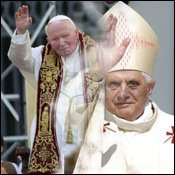Br Andrew Dalton, LC

The Church never ceases to propose models of holiness to her children, and the year 2005 was no exception.
The five new saints of 2005 link the pontificate of John Paul II, who approved their cause of sainthood, to that of Benedict XVI, who canonized them in a single solemn ceremony in Rome on October 23.
The historic canonization ceremony coincided with three significant events: World Mission Sunday, the closing of the Synod of Bishops, and the conclusion of the Year of the Eucharist. In his homily, Benedict XVI gave special relevance to the relation between the Eucharist and the “five new saints who, nourished by Christ the living bread, were converted to love and modelled their whole existence to this!”
For example, St. Zygmunt Gorazdowski (1845-1920) was a Polish diocesan priest who “became famous for the devotion founded on the celebration and adoration of the Eucharist. Living Christ's offering urged him towards the sick, the poor and the needy," Benedict XVI said.
The Holy Father referred to St. Józef Bilczewski (1860-1923) as the Polish archbishop whose “deep knowledge of theology, faith and Eucharistic devotion…made him an example for priests and a witness for all the faithful.”
St. Alberto Hurtado Cruchaga (1901-1952), the first Chilean canonized in history, combined contemplation and action to found the Home of Christ for “the most needy, and for those without a roof, offering them a family atmosphere full of human warmth,” said the pope in his homily.
St. Gaetano Catanoso (1879-1963), founder of the Congregation of the Daughters of St. Veronica and the Missionaries of the Holy Face, “dedicated himself to preaching, to catechesis, to the ministry of confessions, to the poor, to the sick, to the care of priestly vocations.”
St. Felix of Nicosia (1715-1787), a Capuchin priest from Italy, “teaches us to grasp the meaning of family and of service to brothers, showing that true and lasting joy, which every human being’s heart desires, is the fruit of love.”
Between 2000 and 2005, John Paul II proclaimed 61 new saints, among whom are St. Mary Faustina Kowalska, St. Josefa of the Heart of Jesus, St. Katharine Drexel, St. Pio of Pietrelcina, St. Juan Diego Cuauhtlatoatzin, and St. Josemaría Escrivá de Balaguer. During his nearly 27-year pontificate, John Paul II named 482 new saints (an average of more than 17 per year) in 51 ceremonies, the last of which took place in May 2004.
Continuity in pace is to be expected with Pope Benedict XVI, who in the last eight months has already added 23 new blesseds to the Church’s calendar. The Vatican’s online calendar shows plans of more to come in May 2006.
The saintly life and witness of John Paul II, whose death brought more world leaders together than any event in our time, perhaps eclipsed to some extent the news of five new saints. Unprecedented international coverage revealed an earnest desire among lay pilgrims for his “sainthood now.” According to Monsignor Slawomir Oder, who has been entrusted with the canonization cause of John Paul II, the insistent cry of the vox populi contributed to Pope Benedict XVI’s decision to waive the five-year waiting period in opening the cause for canonization last June.
The canonization process involves a two-fold judgment as outlined by the Catechism of the Catholic Church:
By canonizing some of the faithful, i.e., by solemnly proclaiming that they practiced heroic virtue and lived in fidelity to God’s grace, the Church recognizes the power of the Spirit of holiness within her and sustains the hope of believers by proposing the saints to them as models and intercessors. (CCC 828)
During the canonization ceremony, Benedict XVI gave his personal definition of sanctity: “The saint is he who is so fascinated by the beauty of God and by his perfect truth to be progressively transformed by it.”
Despite a year of catastrophes and vast suffering, the People of God persevere in hope. The Catechism explains one reason for this: “The saints have always been the source and origin of renewal in the most difficult moments” (CCC 828).
Sanctity of life was a key theme in the life of the Church in 2005, the Year of the Eucharist. Forty years after the close of the Second Vatican Council, the universal call to holiness continues to find a voice:
Fortified by so many and such powerful means of salvation, all the faithful, whatever their condition or state, are called by the Lord, each in his own way, to that perfect holiness whereby the Father Himself is perfect. (Lumen Gentium, 11 §3)
- © Copyright 2006 Catholic Exchange
Legionary Brother Andrew Dalton studies for the priesthood in Rome.

No comments:
Post a Comment